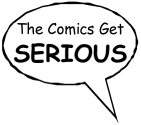

| Lover Boy. By Stanley and Janice Berenstain. New York: Macmillan, 1958; repr., New York: Dell Publishing, 1964. 160p. Cover price, $0.40; available for about $5.00 nowadays. |
|
GENRES: AUDIENCE: SYNOPSIS: EVALUATION: What this book reminds me of is a cross between Family Circus and MAD. (Indeed, at least one cartoon--the "Summer Resort" one--has a very Family Circus-y moment, with the Husband having left footprints in the beach sand to indicate that his journey back from the hot dog stand took several detours round sunbathing women). The atmosphere is naughtier--the husband is constantly chasing women (including his wife) or looking down their decolletage--and has just enough of an edge to make the cartoons more tolerable for me than Family Circus has ever been. But are these cartoons funny? Some are good for a chuckle; "The Complete Ogler" showed a flash of real wit. Some, though not all that funny, are amusing because of how they contrast with what the Berenstains became famous for. Many are the same old same old of the sort that graced countless magazines of the 1950s and that I've seen countless times, so any humor they might have held for me was worn away years ago. (The better-known cartoonists of that era were better known for more than just their style--they were more consistently funny! And MAD was never this feeble [not until the 1990s, anyway].) A few are incomprehensible because they deal with topicalities that have no meaning for me in 2000. And some are just plain unfunny, though it's possible that some of them were meant to be unfunny. This unflattering track record may be one reason why this book has not been reprinted despite the Berenstains' later success. (Or the subject matter may have something to do with it.) More interesting than the actual cartoons is the expression of male vs. female as viewed in the 1950s. We have the male breadwinner and the female housewife; the male businessman and the female secretary; the man is in charge of the household finances; the man is obsessed with cars and women, the woman is obsessed with shopping; the man is the fix-it and technologically inclined individual; etc. These stereotypes aren't entirely extinct, of course, but this sort of portrayal is, so this book might be of interest to students of American social history and popular culture. The art--well, we all know how the Berenstains draw. These are simple line drawings, some obviously done very rapidly, appropriate for the one-panel cartoon format. There's something of a focus on women's breasts and butts, but in a very tame, almost adolescent way. (There are, however, several nudes and partial nudes, frontal only, of course.) Though perhaps it only seems that way from the perspective of 2000; maybe this stuff was racy forty years ago. Or maybe I'm just jaded. Given this book's relative inaccessibility (it is available via online auction, though), it's not worth a search except for Berenstain scholars/completists and those interested in historical graphic novels. |
Return to Rational Magic Home
